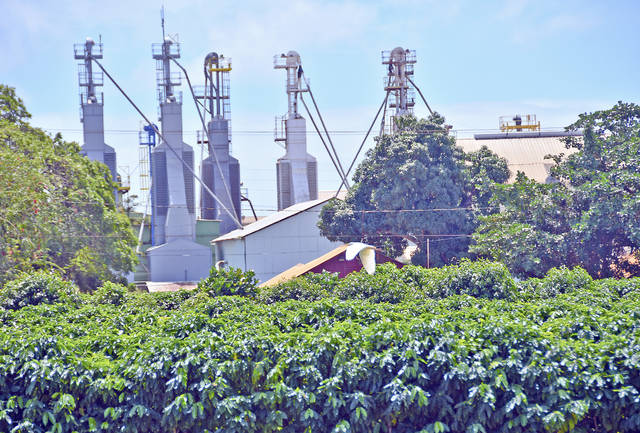KAILUA-KONA — Yield fell while prices remained relatively steady across the Hawaii coffee market during the 2017-18 season, leaving a blend of opinions throughout the industry about its long-term prospects.
The state’s overall coffee production dipped 15 percent to 24.3 million pounds of cherry despite an increase in bearing acreage from 7,000 to 7,300 acres, according to estimates compiled in January by the U.S. Department of Agriculture’s National Agricultural Statistics Service.
The same report, which mails surveys to growers twice annually and conducts telephone follow-ups with non-respondents to gather its data, noted yield per acre dropped to 3,420 pounds of cherry, down 760 pounds from the previous year. The overall value of utilized production also fell from $48.8 million to $43.4 million.
“This is the third year in a row yield has dropped,” said Suzanne Shriner, president of the Kona Coffee Farmers Association and operator of Lions Gate Farms in Captain Cook. “I think it’s too early for us to know for sure why yields have dropped, but we definitely need to look at it. It’s costing our farmers a lot of money.”
She added recent stats have aligned with what she’s heard from Big Island farmers in the Kona Coffee Belt and what she’s witnessed with her own crop, saying there are “thoughts there might be some long-term downward trends” fueling yield reduction.
Andrea Kawabata, extension agent on Hawaii Island with the University of Hawaii at Manoa’s College of Tropical Agriculture and Human Resources, warned survey participation may skew results but added a number of factors might be contributing to the trends Shriner mentioned.
Among them are climate change affecting rainfall totals and the coffee root-knot nematode, which can kill coffee trees or significantly reduce cherry production. The increased threat of the coffee berry borer (CBB) in recent years has also affected yield, Kawabata believes.
Some farmers are beginning to stump their trees or switch to an alternate pruning style, which helps control CBB and the damage it does to crops but leads to a dip in production during the transitional period.
Shriner mentioned irrigation constraints due to the North Kona water crisis also playing a role in yield reduction last season.
“Farms in the Makalei area were explicitly told by the county they had to stop irrigation right at kind of the key production point for the tree,” she said. “I know at least one farmer who went ahead and stumped his trees because if he didn’t get that growth off, they were going to die because they weren’t getting enough water.”
Steve Hicks, chief financial officer at Greenwell Farms, said NASS numbers were consistent with what his company’s operation observed last season. He attributed the lower yield to a harvest period that started late and was highly concentrated, lasting only a few weeks.
Most of the crop in the Kona region is hand-harvested and an existing labor shortage due to a more robust Big Island economy combined with stricter immigration policies and bureaucratic visa programs left a lot of cherry on the tree.
But Hicks also offered an optimistic take, explaining crops are often cyclical and that the crop appears as though it will fare better in the upcoming year than it did during the last.
“It’s not going to surprise me to see yield go back up this coming season,” he said. “We have a good crop on the trees this year (and) the weather conditions have been quite conducive to coffee growth.”
He added a bump in yield per acre average back to the 4,000-5,000 pound range would be promising, describing those numbers as “not alarmingly low.”
Economic impact
The laws of supply and demand would dictate that less product means higher prices, and as far as cherry was concerned, that held true.
Cherry price per pound increased from $1.71 to $1.79, but Shriner said the loss of more than 700 pounds per acre takes $1,400 out of a farmer’s pocket, and that’s just the first figure to consider.
“When you extrapolate out the green (bean) numbers, you’re talking easily $4,000-$5,000 per acre farmers are losing on that yield,” she said.
Statewide price averages on green, which skyrocketed from $10.50 to $16.50 per pound two years ago, dropped to $14.30 last season despite a more significant yield reduction.
Still, Hicks referred to the $14.30 price as “kind of an amazing figure in the history of Hawaii coffee in general” and a good indication of product strength.
Kona coffee specifically remains relatively insulated from variations in statewide green prices due to brand recognition and because no matter the yield, there’s never enough of it to meet global demand.
While Kona coffee labels are frequently selling online and in local stores at well above $30 per pound, and Shriner said their value increases in Asian markets, there’s not a lot of room to hike the price to compensate for the loss of yield.
“We’re kind of at a peak market where our buyers are not willing to go much higher,” she said. “We’re getting a lot back out of that lost yield through the supply, but not nearly what we’re losing. … We’re going to have to squeeze as much value as we can and try and really narrow our markets down to the customers willing to pay the most.”
•••
Max Dible can be reached atmdible@westhawaiitoday.com







HI
I am a student from Hawaii Pacific University, im studying global competition and strategy.
I just read this article https://www.thegardenisland.com/2018/04/08/business/federal-figures-show-decrease-in-coffee-production-across-hawaii/. Me and my study group are making a project about the coffee industry here in Hawaii – is it possible you can e-mail me the report? It will be a big help!
Best regards,
Louise Berntsson